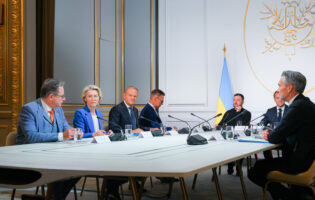Which Carrots and Which Sticks? Searching for a Strategy to Deal with Russia in the Ukraine Crisis

Thomas Mehlhausen
University of Potsdam
Dr. Thomas Mehlhausen was a DAAD/AICGS Research Fellow in 2015 and a postdoctoral research associate and lecturer at the University of Potsdam. He works on the constitutionalization and widening of the European Union. At AICGS, Dr. Mehlhausen will carry out the research project “The Future of the European Neighborhood Policy of the European Union.”
The Western community faces a dilemma in Ukraine. On the one hand, Putin is known to react to pressure with fierce counter pressure.[1] If you bully him into a tight corner, he is most likely to attack. Therefore, a strategy to isolate Russia entails the risk for the West of getting drawn into an enduring conflict with a nuclear power that exerts escalation dominance in Ukraine. On the other hand, Putin has not yet been deterred by existing Western sanctions and is gaining further ground. After the annexation of Crimea, Putin has pushed the front lines ever further into the Donbass.
On top of this psychological ambiguity, Putin succeeded in augmenting decision uncertainty for the West. He sends inconsistent signals by presenting himself at the international negotiation table as being engaged in finding a peaceful solution to the current conflict while simultaneously increasing military presence in the region and supporting the separatists in Ukraine. By creating his own “truth” of an allegedly illegitimate and fascist regime in Kiev and denying direct involvement of Russian soldiers, diplomacy is rendered excruciatingly difficult.
As Putin successfully conceals his intrinsic ambitions in the Ukraine crisis, the West responds with a cautious step-by-step strategy. While this ensures a certain ability to react flexibly, a series of such short-term decisions might lead to a suboptimal situation, e.g., ultimately to an open military conflict between NATO and Russia. Therefore, a promising long-term strategy is needed. For this, we do not need to start from scratch, but may recall the previous Eastern policies of Poland and Germany.
The Polish and German Eastern Policy in Comparison: Learning from Illusions
Poland and Germany are the political heavyweights among EU member states advocating a strong Eastern Partnership (EaP). From an analytical angle, they almost represent ideal types in the classical Weberian sense, given their very distinct assumptions on Russia and the EaP target countries.[2] From a political perspective, their different stances are vital since a compromise between them makes a consensus in the EU-28 likely.
Warsaw’s and Berlin’s different approaches of the past decades can be attributed to varying geographical proximity, economic ties, historical experiences, and resulting perceptions of security threats.[3] Poland took an apprehensive view on Russian imperial claims, which it feared could spill over and imminently threaten its own security.[4] In line with the realist school of thought,[5] Warsaw persistently argued for a containment strategy. Regarding Ukraine as the largest and for long the most promising among reformist EaP countries, Warsaw considered the sovereignty, territorial integrity, and democratic transformation of its eastern neighbor as the best guarantor for its own security. Therefore, Poland has consistently championed a “Ukraine first” approach with the ultimate objective of Ukrainian EU and NATO membership.
In contrast, Berlin has traditionally been much more optimistic about Russian foreign policy. Given Russia’s preponderance in Eastern Europe, any political or economic cooperation was thought to succeed only if Moscow was included or at least consulted. This “Russia first” approach implied that, given the Kremlin’s strong repudiation, EU and NATO membership should not be granted to Ukraine and other EaP countries. The implicit assumption of German Foreign Minister Frank-Walter Steinmeier’s “modernization partnership” is that cooperation leads to incremental transformation of the Russian political system toward Western liberal values, thus creating a gradual convergence of interests.
However, the past decade called the central assumptions of both policies into question. On the one hand, Warsaw became more realistic on Ukraine, which underwent a return to authoritarianism under Yanukovych and had to realize that Kiev does not treat Poland as its main advocate within the EU and NATO. On the other hand, Berlin had to learn the hard way that Russia cannot be assuaged once its national interests are threatened. While such a convergence of Eastern policies may help to foster unity among EU member states, crucial differences still remain as to the Polish stance on Russia and the German view on Ukraine.
Choosing the Middle Ground
Since both Eastern policies have partially failed, a fresh start in the EU Eastern Policy is needed. The current crisis revealed that the Polish fears of a once again aggressive Russia were well founded, as were Warsaw’s calls for a reduction of the EU’s vulnerabilities to preserve its unity in times of crisis. Yet, it is questionable whether realist recipes work given the EU’s limited military power and Russia’s escalation dominance in its so-called “Near Abroad.” The German policy toward Russia hit a solid wall but at least proved to be right in claiming that Moscow should not be sidelined. In the following, I propose a synthetic strategy based on the three principles of military and geopolitical de-escalation, widening the cost-benefit-gap for the Russian policy in Ukraine, and enhancing EU resilience. This is based on the assumption that currently Russia does indeed pose a threat to the European security system and that not increased rivalry but a common vision best ensures sustainable peace in Europe.
Military and Geopolitical De-escalation
Russia demonstrated that it sees its strategic interests in Ukraine at risk and that it is willing to use radical measures to protect them. It considers its Ukraine policy as appropriate in a competition primarily between Russia and the West. While the implicit imperial claims are clearly unacceptable since they bluntly ignore Ukrainian sovereignty, steps that reinforce the perception of such a geopolitical rivalry should be avoided.
Delivery of Lethal Weapons: The provision of lethal weapons to Ukraine as currently discussed in the U.S. intends to raise the costs for Putin to ultimately deter him.[6] A rising number of Russian casualties is expected to increase domestic pressure on Putin to put an end to the war. Moreover, those in favor depict it as a question of credibility to commit to the 1994 Budapest Memorandum where Ukraine was guaranteed its sovereignty and territorial integrity in exchange for relinquishing the world’s third largest nuclear arsenal on its territory. Finally, inaction is considered to further feed Putin’s appetite in other regions of Russia’s “Near Abroad.”[7]
However, such military assistance is merely symbolic and counterproductive. First, it is by no means certain that public support for Russian intervention will decrease as more dead Russian soldiers return home. Instead, the combination of strong patriotism and the Kremlin’s firm grip on national media is likely to ensure that the Russian population will support an open war as an unavoidable measure to defend their compatriots in Ukraine against an allegedly fascist regime. Such a presumption is supported by recent opinion polls of the Russian Levada Center.[8] Second, not only do Ukrainian troops have to be first trained in the use of these weapons, but their delivery will not enable the Ukrainian army to match up with Russian troops at any rate. Therefore, it will neither reinstall the Budapest Memorandum nor deter Russia from further aggression. Instead, it plays into Putin’s hand as then, he might even more convincingly present the conflict to his people as one fought to protect its “fraternal nation” against Western alleged imperialism. Last but not least, delivery of lethal arms is highly controversial among Western countries and might endanger unity.
Ukrainian NATO and EU Membership: The question of Ukrainian NATO membership should be postponed as it decreases security for all participating parties—NATO, Russia, and Ukraine. Russia demonstrated that it is prepared to do almost anything to thwart Ukraine’s NATO accession. More importantly, recent opinion polls indicate that Ukraine is highly divided over the question of NATO membership and consensus is only tangible in case of neutrality.[9] In short, NATO membership would most likely undermine Ukrainian territorial integrity.
EU membership is certainly less controversial in Ukraine. Still, a relative majority in the east and two-thirds in the Donbass reject it.[10] Finally, both EU and NATO membership are thorns in Russia’s side and are likely to unnecessarily escalate the conflict.
Depoliticization of the Eastern Partnership: Eastern Partnership (EaP) failed in its once most promising target state due to the existence of a fierce competitor and its own limited capacities. On the one hand, the creation of the EaP fuelled the rivalry of two competing gravitational centers in Europe. While negotiations between the EU and Russia on the four common spaces were stagnating, the EU pressed for the export of its acquis communautaire to its Eastern neighborhood. Brussels denied Moscow a seat at the negotiation table, although Kiev favored a solution reconciling both integration efforts. On the other hand, EaP did not provide sufficient incentives for its target states. The EU naively expected similar transformation results as in its Eastern enlargement wave, although the EaP states received far less financial aid, could not build on previous democratic experience, were much more linked to Russia, and, most of all, were not given a prospect for membership.[11] The EU did not bestow the capacities to reach its ambitious goal to act as a rule-setter in Eastern Europe.
The EaP thus needs to be revised. In times of intense confrontation, a new peace order should build on the principle of mutual acknowledgement of different political systems. Both Russia and the West should accept not only the inviolability of territorial integrity but also that of the domestic orders.[12] The EaP should focus more on good governance than on democratization, e.g., by promoting an effective anti-corruption policy, infrastructure, social and health policies, or border security. This would allow for a common ground for a more cooperative relationship with Russia.
Maximizing the Cost-Benefit Gap for Russian Policy in Ukraine
In international politics, rational actors weigh the relative costs and benefits of an agreement. Negotiations are only effective if there are win-sets comprising those compromises, which each party is able to domestically implement.[13] From such a theoretical perspective, Putin has not acted irrationally, but rather the West simply miscalculated the value he attributed to fostering Russian influence on Ukrainian foreign policy based on the specific domestic context in Russia. The Kremlin is apparently prepared to pay a high price for keeping a foot in Ukraine (escalation), whereas it demands considerable compensation for meeting Western calls for adhering to Minsk II (cooperation). The previous debate has largely ignored the benefits Putin may reap from stopping Russian aggressions and, for too long, has focused almost exclusively on raising the costs of non-cooperation.
Free Trade Area and Visa Liberalization with Russia: In order to turn the previous geopolitical rivalry into a positive-sum game, we have to envision a mutually beneficial environment. For example, Putin proposed an economic union from Lisbon to Vladivostok in 2010, which Chancellor Angela Merkel and her deputy Sigmar Gabriel declared to be willing to support once progress in the Ukraine crisis has been achieved. The idea of close economic integration with Russia dates back at least to 2003 when the EU and Russia agreed upon the four common spaces.[14] However, the overall results were meager due to divergent expectations and mutual mistrust.
What are the major impediments to a free trade area between the EU and the Eurasian Economic Union (EAEU)? There are political costs on both sides. The EU needs to tolerate the striking value discrepancy and decouple economic liberalization from political convergence. Russia would need to accept that this implies cooperation between two supranational bodies in spite of its traditional preference for intergovernmentalism within the EAEU and for bilateral relations with EU member states. The economic costs seem to be distributed asymmetrically.[15] Given that most imports from Russia and Kazakhstan into the EU are already tariff-free, trade liberalization would imply dismantling tariffs almost unilaterally.[16] Therefore, the EAEU members would most likely prefer a comprehensive economic and trade agreement without the obligation to fully adopt the EU’s acquis communautaire.
Moreover, Moscow has long advocated visa liberalization. The EU member states are confronted with strong domestic resistance but it would be a valuable bargaining chip in the negotiations with Russia and send a conciliatory sign to the Russian people undermining the current anti-Western propaganda.
Sanctions: To be sure, the West needs to stand firm in its condemnation of the current Russian aggressions in Ukraine. The imposed sanctions have put the Russian economy under severe pressure and demonstrate that a disregard for international law will not be tolerated. Should the Kremlin indeed attempt to seize Mariupol and build a land bridge in order to connect the separatist regions with Crimea, further sanctions will become inevitable.
In eastern Ukraine, the Kremlin does not enjoy as much room for maneuver as it did in Crimea, since public opinion neither in the separatist region nor in Russia approve annexation. In the long run, the Ukraine crisis will simply be too costly for Putin to deny cooperation. Therefore, discussing new sanctions appears as important as specifying under which conditions existing sanctions will be lifted since this may encourage the Russian leadership to de-escalate.
Enhancing EU Resilience
The Ukraine crisis revealed the EU’s vulnerabilities. Even though the EU as the most economically viable actor was able to preserve unity to an astonishing extent, the need to agree on the lowest common denominator posed a serious threat to its ability to act coherently.
Energy Union: Its dependency on Russian energy supplies is a recurrent theme in the EU’s Eastern policy.[17] The 2006 and 2009 gas crises and the European Commission’s recent stress test demonstrated the security risks in the energy sector.[18] In order to realize its objectives of stable, affordable, and sustainable energy supplies, the European Commission recently presented its Energy Union Package.[19] The increased number of interconnectors, reverse flow capabilities, and storage facilities as well as the Third Energy Package that decouples energy production and transport certainly enhanced energy security and increased competition between national producers. However, different levels of national competitiveness and energy mixes pose challenges to common approaches. They might become less stark if the Ukraine crisis leads to a shift of priorities toward further securitization of the EU energy policy.
Two measures might help to further strengthen EU resilience in the energy sector. First, enhanced energy efficiency accomplishes all three goals of energy security, low prices, and sustainability, for example by further insulation of buildings or improving road vehicles. Second, former Polish Prime Minister Donald Tusk proposed to further mutualize and supranationalize the purchase of natural gas.[20] If his eager proposal were at some time to be implemented, Russia would no longer be able to pit EU member states against each other. The EU Energy Union as proposed by the European Commission is a first step in the right direction but could be more ambitious.
Solidarity Fund: One of the major challenges to a coherent response to the Russian provocations is the divergence of national interests due to different expectations on trade losses in case of increased confrontation. Therefore, the solidarity clause in the Lisbon Treaty (Article 222) should not only apply to terrorist attacks and man-made and natural disasters, but should be extended to severe conflicts with third parties. This clause needs further specification to define under which conditions member states may claim allowances in order to compensate for uneven ramifications of sanctions by or against member states. Once the costs of an assertive EU foreign policy are fairly distributed among member states, national interests converge and the likelihood of a consensus in the EU-28 increases. In future foreign policy crises, it reduces the chances of third states to drive a wedge between EU member states’ unity.
Conclusions
If the Western policy toward Russia follows a carrot and stick approach, this article raises the questions as to which carrots are on offer, which sticks should be used, and how the EU may increase its resilience in case of further backlashes by Russia. Our choice of strategy must necessarily reflect our assumptions on Putin’s ultimate objectives. If he indeed pursues an offensive plan to subjugate Russia’s “Near Abroad,” the cautious approach proposed here is likely to fail. If, however, Putin attempts to “simply” defend what he considers the Russian sphere of influence, then the proposed strategy may change his calculus, eventually transforming Eastern European politics from a rivalry into a cooperative endeavor toward mutual prosperity. In that case, the proposed strategy best ensures a lasting peaceful solution to the current crisis in Ukraine.
Dr. Thomas Mehlhausen was a DAAD/AGI Research Fellow in February and March 2015. He is a postdoctoral research associate and lecturer at the University of Potsdam.
[1] I would like to thank Jeremy Shapiro, Hans Binnendijk, and Paul Saunders for their inspiring comments.
[2] The EaP addresses Belarus, Ukraine, Moldova, Georgia, Armenia, and Azerbaijan.
[3] On the Polish and German Eastern policy see Kai-Olaf Lang, “Polen, Deutschland und die EU-Ostpolitik: Spannungsfelder und Kooperationspotenziale,” in Deutschland und Polen. Die europäische und internationale Politik, ed. Thomas Jäger, Daria D. Dylla (Wiesbaden: VS, 2008),123-136.
[4] The term “Near Abroad” is used by Russia to refer to the former Soviet Republics and marks the priority of this region in Russian foreign politics.
[5] See Kenneth Waltz, Theory of international politics (Boston et al.: McGraw-Hill, 1979).
[6] For an argumentation in favor of arms delivery see Steven Pifer and Strobe Talbott, “Arming the Ukrainians and Russia’s Reaction,” 2015, http://www.brookings.edu/blogs/up-front/posts/2015/02/04-arming-ukrainians-russias-reaction-pifer-talbott and Ivo Daalder et al., “Preserving Ukraine’s Independence, Resisting Russian Aggression. What the United States and NATO Must Do,” Atlantic Council 2015. For a rejection of military assistance see particularly Jeremy Shapiro, “Why Arming the Ukrainians is a Bad Idea,” 2015, http://www.brookings.edu/blogs/up-front/posts/2015/02/03-why-arming-ukrainians-is-a-bad-idea-shapiro and John J. Mearsheimer, “Don’t Arm Ukraine,” The New York Times, 8 February 2015, http://www.nytimes.com/2015/02/09/opinion/dont-arm-ukraine.html?_r=0.
[7] See Michal Baranowski, “Expand the Negotiations Format and Provide Military Aid to Ukraine,” 2015, http://www.gmfus.org/blog/2015/01/28/expand-negotiations-format-and-provide-military-aid-ukraine.
[8] Even though an absolute majority does not approve of an intervention of Russian troops in Ukraine (60 percent against, 25 percent in favor), a relative majority would still support the Russian leadership in case of an open war between Russia and Ukraine (44 percent in favor, 39 percent against), Levada Center, “The Ukraine Crisis,” 11 March 2015, http://www.levada.ru/eng/ukraine-crisis.
[9] While nationwide a slim absolute majority considers NATO membership acceptable or just tolerable, 68 percent in the east and 82 percent in the Donbass region reject it. In contrast, 63 percent regard neutrality as acceptable or just tolerable nationwide, the west is split (48 percent reject it and 48 percent could accept or tolerate) and the east overwhelmingly approves of it (74 percent). Program for Public Consultation, “The Ukrainian People on the Current Crisis,” 2015, http://www.public-consultation.org/studies/Ukraine_0315.pdf.
[10] Program for Public Consultation, “The Ukrainian People on the Current Crisis,” 2015, http://www.public-consultation.org/studies/Ukraine_0315.pdf.
[11] See Frank Schimmelfennig, “Europeanization beyond Europe,” Living Reviews in European Governance 1/7 (2012).
[12] See Markus Kaim, Hanns W. Maull, Kirsten Westphal, “Die gesamteuropäische Ordnung vor einer Zäsur – drei Leitlinien für einen Neubeginn,” SWP Aktuell (2015), http://www.swp-berlin.org/fileadmin/contents/products/aktuell/2015A14_kim_mul_wep.pdf.
[13] See Robert Putnam, “Diplomacy and Domestic Politics: The Logic of Two-Level Games,” International Organization 42 (Summer 1988), 427-460.
[14] See European Commission “EU-Russia Common Spaces. Progress Report 2012,” 2013, http://eeas.europa.eu/russia/docs/commonspaces_prog_report_2012_en.pdf.
[15] See Rilka Dragneva; Kataryna Wolczuk, “Russia, the Eurasian Customs Union and the EU: Cooperation, Stagnation or Rivalry?” Chatham House Briefing Paper 2012/01.
[16] See Michael Emerson, “Trade policy issues in the wider Europe – that led to war and not yet to peace,” CEPS Working Document 398 (2014), 10.
[17] The EU-28 imports 34 percent of its crude oil, 39 percent of its natural gas, and 28 percent of its coal from Russia, though the national shares vary drastically across member states.
[18] European Commission, “Gas stress test: Cooperation is key to cope with supply interruption,” 2014, http://europa.eu/rapid/press-release_IP-14-1162_en.htm.
[19] European Commission, “Energy Union Package,” 2015, http://ec.europa.eu/priorities/energy-union/docs/energyunion_en.pdf.
[20] “Donald Tusk on the Polish project of the European Union Energy Union,” Office of the Premier, 2014, https://www.premier.gov.pl/en/news/news/donald-tusk-on-the-polish-project-of-the-european-energy-union.html.








